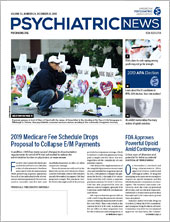Eating disorders are common mental disorders that can lead to serious psychiatric, medical, and social disabilities. However, many psychiatrists and other mental health professionals have limited knowledge to assess and treat eating disorders. This article briefly reviews current information about assessing and treating these disorders with the aim of helping increase the knowledge of nonspecialists to identify and treat more patients with these problems.
Problematic eating can be identified by asking screening questions such as these: Are you satisfied with your eating pattern? Do you ever eat in secret? Does your weight affect the way you feel about yourself? Have any members of your family had an eating disorder? Do you have or have you had an eating disorder?
Anorexia nervosa (AN), an eating disorder with a high mortality rate and characterized by low body weight and extreme fear of weight gain, has a prevalence of approximately 1 percent. Unfortunately, medications and psychosocial treatments such as cognitive-behavioral therapy (CBT) have only limited effectiveness in adults with AN.
Treatments are more effective for younger patients with short-duration AN. Family-based treatment (FBT) helps parents learn to be effective in combating behaviors that maintain low weight and overexercise. In contrast, adolescent-focused therapy (AFT) targets developmental issues related to maturity, social and family relationships, and self-esteem as underlying AN behaviors. Approximately 30 percent to 45 percent of AN patients can fully recover using these approaches.
Bulimia nervosa (BN) has a prevalence rate of about 3 percent and, like AN, is much more common in women than men. People with BN are highly invested in their appearance and weight. The disorder often begins in the context of dieting. As a result of undereating, urges to eat increase and ultimately lead to binge-eating episodes and feelings of being unable to control eating. These episodes are followed by guilt and worry about weight gain; thus, strategies to compensate for the increased intake through purgative behaviors such as vomiting and laxative use begin.
Depression and substance use and abuse commonly co-occur in patients with BN. The most effective treatment for BN in adults is CBT, which focuses on using behavioral and cognitive-skill development to challenge the maintenance of behaviors that lead to binge eating and purging. About 30 percent to 35 percent of patients with BN recover with CBT. Interpersonal psychotherapy (IPT) is also effective but focuses on changing interpersonal relationships rather than binge eating or purging directly. While IPT is effective, it is slower in accomplishing its effects. Antidepressant medications also decrease binge eating and purging but are most useful as adjunctive treatments to CBT. For younger patients, CBT is also effective, but FBT works more quickly.
Binge-eating disorder (BED) is a new diagnosis in DSM. BED has a prevalence rate of about 3 percent and is equally common in both men and women. Patients with BED binge eat but do not adopt compensatory behaviors. Nonetheless, BED is associated with significant emotional distress, physical, or social impairment; depression, anxiety, and substance use disorders commonly co-occur. With ongoing BED, weight gain is inevitable and often accompanied by the medical consequences of obesity including hypertension, diabetes, sleep disorders, and joint problems. There are several effective treatments for BED including CBT, IPT, and dialectical behavioral therapy (DBT).
The specific form of DBT used for BED targets binge eating as a maladaptive attempt to cope with emotional states. Although a number of medications may be helpful with BED, only lisdexamphetamine dimesylate, a stimulant originally indicated for attention-deficit/hyperactivity disorder (ADHD), is approved by the Food and Drug Administration. Unfortunately, although patients may improve using these approaches, weight loss remains very limited.
Another eating disorder that is new in DSM is avoidant restrictive food intake disorder (ARFID). Unlike AN or BN, eating behavior is not based on worries about appearance, weight, or shape, and weight loss is not intentional. However, individuals with this disorder can experience nutritional deficiencies, severe malnutrition, and behavioral, emotional, and psychological problems. Patients can develop ARFID at any time, but it is most common in school-aged children. Some present with highly selective or picky eating, others develop extreme fears about eating related to anxiety about choking or swallowing, and others are not motivated to eat enough due to low interest in eating or low appetite. No evidence-based treatments have been identified for ARFID yet; therefore, most treatments are individualized and aimed at achieving normal eating patterns to promote health and social development.
Through brief screening, a basic understanding of the main types of eating disorders, and familiarity with effective treatment approaches, psychiatrists and other mental health professionals can successfully treat these patients. For more complex cases, referral to specialty treatment may be indicated. Resources are available to learn CBT, IPT, and FBT through published manuals and training events. The prevalence and clinical needs of patients with eating disorders far exceed the capacities of specialty centers. Thus, more community-based psychiatrists and other mental health professionals are needed to identify and treat these common disorders. ■

